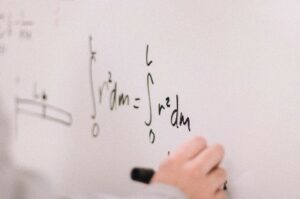News & Events
May 13, 2022
What Kind Of Math Is Used In Electrical Careers?

Math, physics, and algebra are critical to everything an electrician does, whether taking measurements or calculating voltages and power. Anyone looking to become an electrician needs a background in basic mathematics. That forms the core math used in routine measurements and calculations at work. Below is a look at different kinds of math used in electrical careers:

Understanding math is crucial to an electrician’s success.
Trigonometry & Geometry
Electricians use trigonometry and basic geometry principles during installations, repair, and maintenance. Trigonometry is a math branch dealing with the sides and angles of triangles. Electricians can apply tangent functions to determine the ideal angles to bend conduit sections along the proper wiring route.
Trigonometry has various other operations taught during electrician training.
Students can figure out the different equations and functions and apply them comfortably when wiring a building in real-life situations. Simple geometry concepts like Pythagorean Theorem are also vital in helping electricians grasp the basics of AC power. Most training programs feature trigonometry focusing on functions and aspects used in an electrician’s day-to-day work.
Algebra & Calculus
Algebra allows electricians to work comfortably with unknown variables when calculating the known. There are many situations when electricians and electrical engineers call on their algebraic skills to solve complex problems. Introductory algebra learned in high school is the starting point. Electricians have more robust equations and variables to factor, featuring Boolean algebra and numbers with real and imaginary roots.
Calculus is another essential math used in electrical careers. It’s the math of change and part of many electrician calculations. Calculus can determine the number of amps and bulbs needed for the project. It’s also essential in calculating power and voltages. Students looking to become electrical engineers will learn advanced integral and differential calculus.
OHM’s Law
It’s normal to encounter OHM’s Law during physics classes, but physics involves lots of math, and the two often overlap. Anyone looking to become an electrician should master OHM’s Law as it is an equation synonymous with electrical circuits. The basic equation (E = I x R) or (voltage = current x resistance) expresses why OHM’s Law is vital in studying electrical circuits and calculating current, resistance, and voltage.
Electricians need accurate numbers when figuring out the current, voltage, and resistance requirements and limitations. Mastering OHM’s Law makes it easier to determine power loss, voltage drops, the current passing through a circuit, conductor resistance, and more. The law allows electricians to apply logical thinking, practical math, and problem-solving skills during wiring, installation, and repairs.
Become an Electrician
You need thorough understanding of different kinds of math to become an electrician. Logarithms, calculus, statistics, algebra, geometry, and trigonometry are essential for advanced electrical calculations. This career also requires various other skills, including problem-solving, time management, working with others, communication skills, honesty, and patience.
At IEC – Independent Electrical Contractors, we welcome all aspiring electricians looking for a solid foundation to pursue or advance their careers. Since 1957, we’ve offered aspiring electricians apprenticeships, training, licensing, and professional help. We also provide electrical job placements in the Greater Cincinnati Area if you’re already a qualified electrician within the Tri-State.